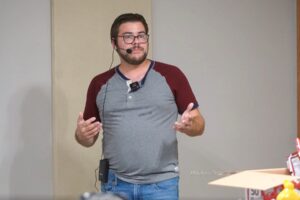Historian Dave Baker Takes Guests On A Tour Of The Tri-County Area
by Ken Allsup and Dave Baker
September 23rd, 2022
Eddyville, Iowa – Polished chrome, slick tires, and shiny paint jobs were all part of the car show hosted at the Eddyville Historical Museum earlier this week.
Inside the museum, there was a variety of food for those not only at the car show but those arriving to hear historian Dave Baker of the 29th State.
Baker, who travels around Iowa, digging up the bones of Iowa’s lost communities, was the guest speaker for the evening.
Baker spent over a decade studying about, then driving to, those lost communities, where he often took photos of the last remaining structure, or in the worst case, a field that was once the home for a community.
During the just over hour-long program, Baker highlighted some of those communities that were or had been located in Wapello, Monroe, and Mahaska Counties.
Dave Baker wrote about the experience of not only presenting at Eddyville, but the year as a whole, and his words follow below.
Nine public shows in nine different locations, plus two private events. Portraying four different Iowans in three different eras. 2022 has been a wild year for me and The 29th State, but I wouldn’t have it any other way. After spending all of 2020 sidelined and with only a handful of programs in 2021, I finally feel like I’m back–getting people excited about Iowa and Iowa History.
The 29th State has always been a “hobby,” project, something that fills the time. Of course, with a full-time job and a family with two small children, there is less time to be filled these days–and I should mention, I’m writing a book as well on Central Iowa. What possesses a person to spend two hours before everyone is up each morning–and many nights, at least an hour after everyone has gone to bed writing history? I can tell you; it’s more than history.
Every day I get to read peoples’ interactions on The 29th State. I see them reconnect with long-lost friends, former neighbors, and occasionally even family members. They share their stories, often funny, sometimes heartbreaking–and always personal about the places photographed. Sometimes people will argue over the details; blending where fact, fiction, and folklore meet. Above all, I do it for the community. Humans need a sense of belonging, and our collective heritage is a place where we can easily connect.
At Eddyville, that is precisely what happened. Following the program, people stood around and talked to each other. There were conversations that began with “did you know—” followed by, often, affirmative responses. If the attendees didn’t know one another, they seemed to share at least one common acquaintance. It was fascinating to watch this. People were genuinely bonding over places like Bidwell, Haydock, and Hynes.
Researching the Eddyville program began like most of my research begins. I seek to discover why a place was important. Maybe it had a busy train station or was the site of a church community. Perhaps people attended a country school in a particular place or there was a coal mining camp. Some places–like Pekay and Lost Creek have more nefarious claims to fame with their infamous mining disasters. All of them have stories to tell.
What made this program so interesting to research and work on was the wide variety of communities that were available from which I could draw information. Eddyville is uniquely located at the confluence of three counties. For my purposes, that meant any of the former townsites–formalized and informal were fair game. Hynes, Cuba, Bidwell, and Bridgeport were included, of course, because of their proximity. Frederic and Pleasant Corners were close as well as represent the formal railroad community and the ad hoc prairie village. Other towns had interesting stories to tell–like the Wright tornado and the humorous debacle with the Tioga post office.
My research relies heavily on archived newspapers and personal narratives of places, and these resources are abundant in all three counties thanks to groups like the Keo-Mah HistoricalSociety, the Digital News preservation programs, and organizations like the Eddyville HistoricalMuseum. Everyone should take advantage of these wonderful resources in Southern Iowa. Even for those not interested in history, they provide a fascinating insight into the political, economic, and social tendencies of the area. In short, they allow us to understand each other because we understand ourselves and where we came from.
As the 2022 speaking season ends, I can not help but reflect on how enjoyable it was to learn about these communities. While many are no longer extant, my goal is to share their stories and encourage people to learn from them. I would encourage everyone to capitalize on their heritage and use it to build better relationships with your neighbors, communities, and ultimately the world.











